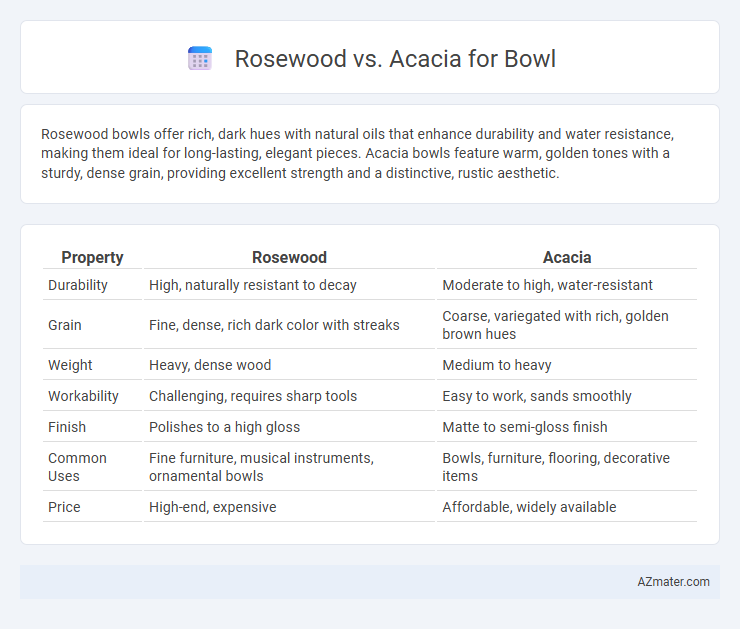Rosewood bowls offer rich, dark hues with natural oils that enhance durability and water resistance, making them ideal for long-lasting, elegant pieces. Acacia bowls feature warm, golden tones with a sturdy, dense grain, providing excellent strength and a distinctive, rustic aesthetic.
Table of Comparison
| Property | Rosewood | Acacia |
|---|---|---|
| Durability | High, naturally resistant to decay | Moderate to high, water-resistant |
| Grain | Fine, dense, rich dark color with streaks | Coarse, variegated with rich, golden brown hues |
| Weight | Heavy, dense wood | Medium to heavy |
| Workability | Challenging, requires sharp tools | Easy to work, sands smoothly |
| Finish | Polishes to a high gloss | Matte to semi-gloss finish |
| Common Uses | Fine furniture, musical instruments, ornamental bowls | Bowls, furniture, flooring, decorative items |
| Price | High-end, expensive | Affordable, widely available |
Introduction: Comparing Rosewood and Acacia for Bowls
Rosewood offers deep, rich tones with natural oils that enhance durability and a smooth finish, making it a popular choice for high-quality bowls. Acacia features a striking grain pattern with lighter hues and natural resistance to moisture, ideal for functional and decorative bowls. Both woods provide unique aesthetic appeal and strength, but Rosewood leans towards luxury and Acacia towards versatility.
Rosewood Overview: Characteristics and Origins
Rosewood, prized for its rich hues ranging from deep reddish-brown to purplish-black, is a dense hardwood known for its natural oils that enhance durability and resistance to moisture, making it ideal for crafting bowls. Originating primarily from tropical regions such as India, Brazil, and Madagascar, Rosewood features a tight grain pattern that lends a smooth, lustrous finish to wooden items. Its high oil content and density contribute to its natural antibacterial properties, making Rosewood bowls both aesthetically pleasing and highly functional.
Acacia Overview: Characteristics and Origins
Acacia wood is prized for its durability, natural water resistance, and rich, warm hues ranging from light amber to deep brown, making it ideal for bowls that require both strength and aesthetic appeal. Originating primarily from Australia, Southeast Asia, and Africa, Acacia trees thrive in diverse climates, contributing to the wood's dense grain and unique patterns. Compared to Rosewood, Acacia offers a more sustainable option with its faster growth rate and widespread availability, while maintaining a luxurious finish that enhances the bowl's visual and tactile qualities.
Durability and Hardness: Rosewood vs Acacia
Rosewood is renowned for its exceptional durability and high hardness rating, making it resistant to scratches and dents, which is ideal for long-lasting bowls. Acacia, while also durable and hard, generally ranks slightly lower than rosewood in hardness but offers excellent resistance to wear and moisture. Both woods provide sturdy options, but rosewood's superior hardness ensures greater longevity and resilience in high-use kitchenware.
Visual Appeal: Color and Grain Differences
Rosewood exhibits a rich, deep reddish-brown hue with striking dark streaks and a pronounced, swirling grain pattern that enhances the bowl's visual depth and luxury. Acacia features a lighter golden to medium brown color with varied shades and a tighter, more uniform grain that offers a warm, natural aesthetic. The distinct contrast between Rosewood's dramatic dark tones and Acacia's subtle, vibrant appearance influences the bowl's overall artistic style and desirability.
Maintenance and Care Requirements
Rosewood bowls demand regular oiling with food-safe mineral oil to prevent drying and cracking, maintaining their rich, dark finish. Acacia bowls require occasional conditioning with natural oils like walnut or olive oil to preserve moisture and resist warping. Both woods benefit from hand washing and immediate drying to extend their longevity and retain their aesthetic appeal.
Food Safety and Non-Toxicity
Rosewood offers natural antibacterial properties and is generally considered safe for food contact due to its dense, closed grain that resists moisture and bacteria buildup. Acacia is also food-safe, featuring a hydrophobic surface that deters bacteria and resists staining, making it a popular choice for utensils and bowls. Both woods are non-toxic when untreated and sealed properly, but confirming that finishes are food-grade ensures maximum safety for bowl use.
Environmental Impact and Sustainability
Rosewood harvesting often involves illegal logging and contributes to deforestation due to its high demand and slow regrowth, raising significant environmental concerns. Acacia, by contrast, grows faster and is frequently cultivated in managed plantations, making it a more sustainable choice with lower ecological footprint. Choosing acacia bowls supports conservation efforts and promotes responsible forestry practices.
Price Comparison: Rosewood vs Acacia Bowls
Rosewood bowls generally command a higher price due to their dense grain, durability, and rich reddish-brown color, making them a premium choice for collectors and artisans. Acacia bowls offer a more affordable option with warm, golden tones and natural durability, appealing to budget-conscious buyers seeking aesthetic appeal and functionality. Price variations for both woods depend on bowl size, craftsmanship, and source, but rosewood consistently remains more expensive than acacia in the market.
Final Verdict: Choosing the Best Wood for Your Bowl
Rosewood offers a rich, dark grain and high durability, ideal for bowls requiring a luxurious appearance and long-lasting strength. Acacia displays a warm, golden hue with natural water resistance, making it perfect for everyday use and moisture-prone environments. Select rosewood for elegance and robust wear resistance, while acacia suits functional, attractive bowls with excellent practicality.

Infographic: Rosewood vs Acacia for Bowl
 azmater.com
azmater.com